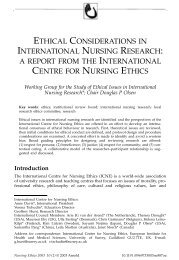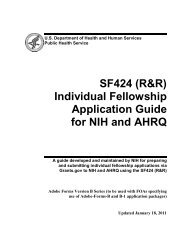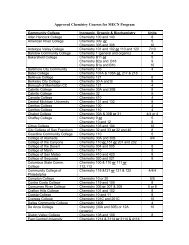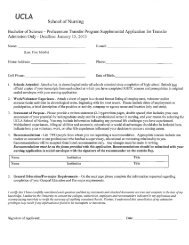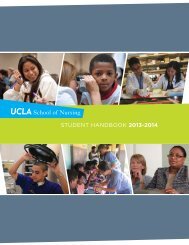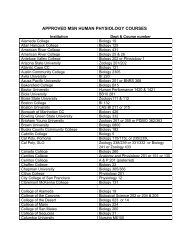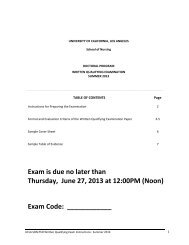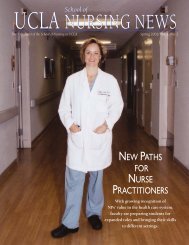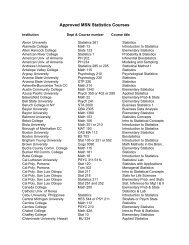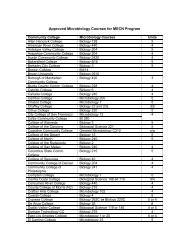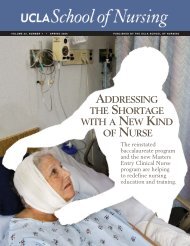Fall 2003 - UCLA School of Nursing
Fall 2003 - UCLA School of Nursing
Fall 2003 - UCLA School of Nursing
- No tags were found...
Create successful ePaper yourself
Turn your PDF publications into a flip-book with our unique Google optimized e-Paper software.
<strong>UCLA</strong> NURSINGVOLUME 19 <strong>2003</strong> ISSUE PUBLISHED BY THE <strong>UCLA</strong> SCHOOL OF NURSINGHIGHestEDUCATION:Doctoral ProgramAdvances <strong>Nursing</strong> Science
Volume 20, <strong>2003</strong> Issue<strong>UCLA</strong> NURSINGSCHOOL OF NURSINGADMINISTRATIONMARIE J. COWAN, R.N., Ph.D., F.A.A.N.DeanADELINE M. NYAMATHI, R.N., Ph.D., F.A.A.N.Associate Dean, Academic AffairsMARY A. WOO, R.N., D.N.Sc., F.A.A.N.Associate Dean, ResearchKAY BAKER, R.N., M.N.Associate Dean, Student AffairsCHANDICE COVINGTON, R.N., Ph.D.LYNN DOERING, R.N., D.N.Sc.Section ChairsJEFFREY WIGINTTONDirector <strong>of</strong> AdministrationSHARON COULTERDirector <strong>of</strong> DevelopmentDONNA McNEESE-SMITH, R.N., Ed.D.Faculty ChairDAN GORDONEditor and WriterMARTHA WIDMANNArt DirectorPhotography:AS<strong>UCLA</strong> (p. 2: Cowan, p. 5: Nyamathi, koniak-Griffin); Reed Hutchinson (p. 3: Doctoral, Post-Doctoral; p. 7: McDaniel, C<strong>of</strong>fey-Love, Crook,Dixon, Conde; pp. 8-10; pp. 12-13; p. 15: Conde;p. 17: Tullman, Robinson; p. 18: Tullman; p. 19);Bob Knight (p. 3: Commencement; p. 4,p. 5: Top Honor); Yvette Roman (p. 5: Doering,Robbins; p. 7: Attin, FitzGerald; pp. 11, 14);Judy Benson (p. 21: Class <strong>of</strong> 1960); Courtesy<strong>of</strong> the <strong>UCLA</strong> <strong>School</strong> <strong>of</strong> <strong>Nursing</strong> (p. 3: Voda; p. 20)4PARTING WORDSExcerpts from speeches at Commencement, Spring <strong>2003</strong>.6HIGHEST EDUCATION:Doctoral Program Advances<strong>Nursing</strong> ScienceThe science <strong>of</strong> nursing has advanced a long way in a relativelyshort period <strong>of</strong> time, and the <strong>UCLA</strong> <strong>School</strong> <strong>of</strong> <strong>Nursing</strong>’s Ph.D.program is one <strong>of</strong> the reasons.16AIMING HIGHER STILL:Postdoctoral Training LaunchesProductive Research CareersThough postdoctoral training is the norm in most scientificdisciplines, it is relatively new to nursing. But it’s starting tobecome much more common.20THE REWARDS OF GIVING22SCHOOL OF NURSINGANNUAL GIVING4616<strong>UCLA</strong> <strong>Nursing</strong> is published by the <strong>UCLA</strong> <strong>School</strong><strong>of</strong> <strong>Nursing</strong> for the alumni, faculty, students, staffand friends <strong>of</strong> the school.For information about academic programs andstudent affairs, call (310) 825-7181, or e-mail:sonaff@sonnet.ucla.eduDean’s Office: (310) 825-9621Copyright <strong>2003</strong> by The Regents <strong>of</strong> the University<strong>of</strong> California. Permission to reprint any portion <strong>of</strong><strong>UCLA</strong> <strong>Nursing</strong> must be obtained from the editor.Contact Editor, <strong>UCLA</strong> <strong>Nursing</strong>, Box 951702, LosAngeles, CA 90095-1702.20
PARTING WORDSExcerpts from speeches at Commencement, Spring <strong>2003</strong>MADY STOVALLRepresenting the A.D.N.-B.S.-M.S.N. ClassWe’re a small group. Individually, we comefrom diverse backgrounds: farming towns, hugecities, other countries. We range in age from 23to 48. Some <strong>of</strong> us are single, some are marriedwith children and some are single with children.We all received scholarships that covered our educationalexpenses, but not things like food,clothing and shelter, so we all had to work.Before we came to <strong>UCLA</strong>, what the 15 <strong>of</strong>us had in common was that we were practicingregistered nurses. To enter the program, we hadto have at least one year <strong>of</strong> hospital or clinicalexperience, and many <strong>of</strong> us had quite a bit moreexperience dealing with patients. We also sharedsomething else: an attitude – we wanted morepersonally and pr<strong>of</strong>essionally.Throughout our time here, we have had toadjust schedules and budgets and priorities, andjuggle full- and part-time nursing jobs so thatwe could learn more about our pr<strong>of</strong>ession. Butit didn’t stop with pure learning. My classmateswere instrumental in hands-on, communityhealth care projects, like launching an educationalprogram at the Venice Family Clinic waitingarea, organizing and conducting asthma managementclasses, teaching at community andschool health fairs, providing services for NativeAmericans, ministering to the homeless on SkidRow, and creating a promotional video for theUnion Rescue Mission.<strong>UCLA</strong> has one <strong>of</strong> the top five nursingschools in the country, and we are proud to beeven a small part <strong>of</strong> it. The “bridge” programis unique because the Bachelor <strong>of</strong> Science degreeis only a pause in an accelerated curriculum thatends with a Master’s in <strong>Nursing</strong>. The 15 <strong>of</strong> ushere today probably haven’t taken ownership <strong>of</strong>our accomplishment yet. There’s plenty <strong>of</strong> workthat still needs to be done.4 <strong>UCLA</strong> NURSINGAILEEN KIZLINSKIRepresenting the M.S.N. ClassIt seems like just yesterday we were all sitting inorientation. We were unsure what the next twoyears would entail, not knowing what an incrediblejourney we would be embarking on. Todaywe are advanced practice nurses, ready to meetthe challenges <strong>of</strong> the working world.When asked what going back to school waslike, my answer was always “it’s hard,” becauselife went on. My fellow classmates were dealingwith many personal highs and lows. My low wasbeing diagnosed with Hodgkin’s lymphoma, atype <strong>of</strong> cancer, one month after starting school.Going through chemotherapy and radiationwhile attending classes wasn’t always easy. Therewere times when I thought about quitting. Butbeing an advanced practice nurse has been adream <strong>of</strong> mine since I graduated with my firstnursing degree. Was I going to let a little thinglike cancer get in the way?We are all connected by our continued determinationand perseverance despite what lifewas presenting us. We represent positive rolemodels for our patients and are examples <strong>of</strong> theamazing accomplishments one can achieve whenthe drive and desire are so strong.As advanced practice nurses we will workin many different areas. We will be nurse practitioners,clinical nurse specialists, nurse administrators,and nurse midwives. We will be instrumentalin positively changing health care throughresearch, education and policy reform. One <strong>of</strong> myclassmates has already been to Washington,D.C., to meet with lawmakers. Others have volunteeredto work in third-world countries providingmuch needed medical care. Others havebeen involved in nursing research that will be influentialin improving the quality <strong>of</strong> care weprovide to our patients.I am so proud <strong>of</strong> all <strong>of</strong> us.FRANCISCO CONDERepresenting the Ph.D. ClassOver the years, we have seen continued improvementsand discoveries in nursing science andtechnology. We have done a tremendous job inour doctoral program. Dr. Gloria Juarez useda qualitative approach to find the meaning <strong>of</strong>caregiving among Hispanic caregivers. Dr.Lorna Kendrick examined depression amongAfrican American youths. Dr. Susan Robertsinvestigated factors that are associated withcondom use in low-income Latina women, andDr. Leah Fitzgerald studied the immune function<strong>of</strong> patients with irritable bowel syndrome.As we move forward in our journey in researchand academia, we face challenges. There is ahuge shortage in nursing. Our economy is weak.The budget for education is decreasing. Fundingfor research is becoming more competitive.It is during these challenging times that Iam reminded <strong>of</strong> my hero, Lieutenant RodolfoRicafort. At the age <strong>of</strong> 2, I was the mascot formy father, who was an Air Force pilot in hissquadron. On November 5, 1971, our planecrashed in the sea, killing four people, includingmy father, while four <strong>of</strong> us survived. Fortunately,Lieutenant Ricafort saved me.I share my story with you because as doctoral-preparednurses, we have the potential toaffect the lives <strong>of</strong> many. As educators, we havethe opportunity to recruit, teach, and mentornursing students and student nurses who, inturn, will serve others. Through our research asnurse scientists, we can make a positive impactin a population, in our community, and to society.Yes, we face numerous challenges, but let uslook at these difficulties as opportunities to examineourselves and grow, to make a differencein our society today, and to not simply walk inthe shadows <strong>of</strong> our heroes and leaders, but becomeheroes and leaders ourselves.
NYAMATHI, KONIAK-GRIFFINTO HOLD ENDOWED CHAIRSDrs. Adey Nyamathi (left) and Deborah Koniak-Griffin (right) havebecome the second and third holders <strong>of</strong> endowed chairs at the <strong>UCLA</strong><strong>School</strong> <strong>of</strong> <strong>Nursing</strong>.Endowed chairs are created as a result <strong>of</strong> major gifts to theschool in order to attract and support the work <strong>of</strong> a distinguishedfaculty member. Gift funds for the chair are invested, and resulting interestincome is used to support the teaching and research activities<strong>of</strong> the pr<strong>of</strong>essor selected to hold the chair. The two new chairs at theschool are the Audrienne H. Moseley Chair in Community HealthResearch, held by Nyamathi; and the Audrienne H. Moseley Chair inWomen’s Health Research, held by Koniak-Griffin.Nyamathi, associate dean for academic affairs at the school, is arenowned researcher who has focused on providing interventionprograms to homeless and drug-addicted populations at risk for HIV,tuberculosis, and hepatitis A, B and C infections.Nyamathi recently completed a National Institute <strong>of</strong> Drug Abuse(NIDA)-funded grant, “TB/HIV Risk Reduction with Homeless andDrug-Addicted Persons,” evaluating the effectiveness <strong>of</strong> a nursecase-managed, incentive-based intervention program focused oncompletion <strong>of</strong> a TB chemoprophylactic treatment, and secondarily onHIV risk reduction. She also has a new NIDA-funded grant, “HBVVaccination Among Homeless At Risk for HIV,” which will investigatethe effectiveness <strong>of</strong> two approaches <strong>of</strong> care in enhancing compliancewith HBV vaccine among homeless men and women. Nyamathi isprincipal investigator on four additional studies; her research is conductedin both the Skid Row and South Central areas <strong>of</strong> Los Angelesand North and South India.Koniak-Griffin, director <strong>of</strong> the Center for Vulnerable PopulationsResearch (CVPR) and its Administrative Core since 1999, is a pr<strong>of</strong>essorin the school and a nationally certified women’s health care nursepractitioner. Her federally funded program <strong>of</strong> research focuses oncommunity-based nursing interventions to reduce risk and promotehealth <strong>of</strong> young parents <strong>of</strong> predominantly Latino and African Americanbackgrounds.Among the research projects currently headed by Koniak-Griffinare “Preventing HIV/AIDS in Teen Mothers and Their Partners,” aclinical trial evaluating the effects <strong>of</strong> a culturally appropriate, theoryderivedand couple-focused HIV prevention program for adolescentmothers and their male partners, predominantly poor Latinos; and“Lay Health Advisors and Health Education,” a study that employsparticipatory research methods to design and implement a projectevaluating “Su Corazon, Su Vida” (“Your Heart, Your Life”), a cardiovasculardisease risk reduction intervention by Latina lay health advisors,implemented in Spanish to Latinos in the community (mostlyfemale, low-income and immigrants). Results support the effectiveness<strong>of</strong> the program in improving lifestyle behaviors in relation tonutrition, exercise and overall health knowledge.TWO MORE FACULTY NAMEDFELLOWS OF AMERICANACADEMY OF NURSINGDrs. Lynn Doering (left) and Wendie Robbins(below, left) are being inducted asfellows <strong>of</strong> the American Academy <strong>of</strong> <strong>Nursing</strong>,adding to an impressive list <strong>of</strong> <strong>UCLA</strong><strong>School</strong> <strong>of</strong> <strong>Nursing</strong> faculty with the prestigiousF.A.A.N. designation.Doering’s research focuses on testingnursing interventions to promote evidencebasedpractice in cardiovascular nursing.Among her current research projects, sheheads a study funded by the National Institute<strong>of</strong> <strong>Nursing</strong> Research to test a cognitivebehavioral therapy delivered at home towomen who are severely depressed aftercoronary bypass graft surgery. The studymeasures immune responses with and withoutthe therapy.Robbins was a nurse practitioner for more than a decade beforereturning for her Ph.D. in the area <strong>of</strong> molecular-genetic biomarkersand their application in human field study. Her primary researchfocuses on effects <strong>of</strong> environmental, occupational, and lifestyle exposureson DNA integrity in germ cells. Current projects include characterizingsperm DNA damage related to pesticide exposures in farmworkers in China and Mexico, HIV anti-retroviral therapies, and occupationalexposure to boron.Criteria for membership in the American Academy <strong>of</strong> <strong>Nursing</strong>include recognition by one’s peers <strong>of</strong> having made outstanding contributionsto nursing over and above those required in one’s position<strong>of</strong> employment. Faculty from the school who previously were inductedinclude Drs. Nancy Anderson, Lina Badr, Mary Canobbio, SuzetteCardin, Betty Chang, Marie Cowan, Jacquelyn Flaskerud, AnnaGawlinski, Deborah Koniak-Griffin, Mary Ann Lewis, Adey Nyamathi,Sharon Reeder, Linda Sarna, Gwen van Servellen, Donna Ver Steeg,and Mary Woo.TOP HONOR – AT THE <strong>UCLA</strong> SCHOOL OF NURSING <strong>2003</strong> COMMENCEMENT CEREMO-NY, CHANCELLOR ALBERT CARNESALE PRESENTED REP. LOIS CAPPS WITH THE <strong>UCLA</strong>MEDAL, THE UNIVERSITY’S HIGHEST HONOR. LOIS CAPPS HAS ENJOYED AN EXTRAOR-DINARY CAREER AS A NURSE, TEACHER, HEALTH ADVOCATE, AND ELECTED OFFICIAL.SHE IS CURRENTLY IN HER SECOND FULL TERM AS A U.S. CONGRESSWOMAN FROMCALIFORNIA, REPRESENTING THE 23RD CONGRESSIONAL DISTRICT.<strong>UCLA</strong> NURSING 5
HIGHestEDUCATION:Doctoral ProgramAdvances <strong>Nursing</strong> ScienceBEFORE THE 1970S, FEW DOCTORAL PROGRAMS WERE OFFERED TO NURSES, AND FEW NURSES PUR-SUED THEM. (THOSE WHO DID USUALLY GOT THEIR DOCTORATES IN EDUCATION, AND TENDED NOT TOThe science<strong>of</strong> nursinghas advanced along way in arelatively shortperiod <strong>of</strong> time,and the <strong>UCLA</strong><strong>School</strong> <strong>of</strong> <strong>Nursing</strong>’sPh.D. program isone <strong>of</strong> the reasons.PURSUE RESEARCH CAREERS.) AS A RESULT, ISSUES FUNDAMENTAL TO THE PROFESSION – SUCH ASEMPIRICAL EVIDENCE OF NURSES’ CONTRIBUTIONS TO POSITIVE PATIENT OUTCOMES AND THE EFFEC-TIVENESS OF NURSING INTERVENTIONS – WERE NOT ADDRESSED, LEAVING NURSES TO RELY ON FOLK-LORE, ANECDOTES AND INSTINCT.That began to change in the 1970s, when thefederal government provided funding for nursesto pursue doctorates in other disciplines – includingsociology, psychology, anthropology, andphysiology. These nurses, upon graduation,formed the basis on which many doctoral programsin schools <strong>of</strong> nursing were established,now that there were doctorally prepared nursesto teach a new generation <strong>of</strong> scholars – trained,this time, in the science <strong>of</strong> nursing.The momentum grew stronger in the 1980s,as federal research dollars began to be madeavailable for nurse scientists. In 1986, the NationalCenter for <strong>Nursing</strong> Research was establishedwithin the National Institutes <strong>of</strong> Health.The center was granted institute status in 1991.Its budget for research grants, which started atapproximately $8 million, has grown nearly sixfoldin its short existence. Many <strong>of</strong> those dollarsare going to faculty at the <strong>UCLA</strong> <strong>School</strong> <strong>of</strong> <strong>Nursing</strong>,which is ranked in the top 10 nationally inNIH funding despite having a smaller facultythan the other comparative schools.The <strong>UCLA</strong> <strong>School</strong> <strong>of</strong> <strong>Nursing</strong>’s doctoralprogram was established in 1987, and became aPh.D. program (after <strong>of</strong>fering the D.N.Sc. degree)in 1995. Whereas the master’s degree preparesnurses for advanced clinical practice, thedoctoral program educates scholars who, throughoriginal research and generation <strong>of</strong> theory, buildthe scientific knowledge base that advancesnursing practice and health care policy.Driven by the dramatic increase in doctoralprograms – there are now more than 70 nationally– and the rise in federal funding for the nurse researcherswho graduate from these programs, theknowledge base for nursing science has grownexponentially since the school’s doctoral programwas established 16 years ago, at a time when thescience was in its infancy. Beginning this fall, theschool’s Ph.D. program was substantially restructuredto reflect the areas <strong>of</strong> study in which nursingmakes a significant contribution towardhealth, as defined by the research expertise <strong>of</strong>the school’s faculty. All entering students beginby gaining an overview <strong>of</strong> nursing science andcurrent research, then become expert methodologistsin their second year. Ultimately, though,they follow one <strong>of</strong> four pathways:Biobehavioral Sciences, focusing on theinfluence <strong>of</strong> biologic and behavioral factors onhealth beliefs and health promotion, sense <strong>of</strong>well-being and quality <strong>of</strong> life, symptom managementand adherence to and utilization <strong>of</strong> preventionand treatment services.Biologic Sciences, the phenomena in thebiologic, physiologic and pathophysiologic sciencesincluding cellular adaptations and injury,genetics, neoplasia, inflammatory, immune andneuroendocrine responses and the effect <strong>of</strong> theseon tissue and organ system function in the context<strong>of</strong> human health.6 <strong>UCLA</strong> NURSING
D OCTORAL P ROGRAM P ATHWAYSBiobehaviorial SciencesBiologic SciencesHealth Disparities/Vulnerable PopulationsHealth ServicesHealth Disparities/Vulnerable Populations,focusing on community-based interventionsto prevent disease and decrease morbidityand mortality for populations at relatively highrisk for poor health and in the context <strong>of</strong> a culturallydiverse environment for care.Health Services, the interrelationships <strong>of</strong>structure, process, and outcomes <strong>of</strong> care in thecontext <strong>of</strong> a wide range <strong>of</strong> health care deliverysystems, from inpatient settings to outpatientand home care and community-based preventionand treatment delivery systems.The pathway to prepare biologic nurse scientistsputs the <strong>UCLA</strong> <strong>School</strong> <strong>of</strong> <strong>Nursing</strong> at theforefront <strong>of</strong> nursing doctoral programs nationally,explains Dean Marie Cowan. “Most nurse sciencereflects the behavioral expertise <strong>of</strong> thenurse scientists who were trained in the 1970s,”she says. “There is a great need for biologicallyoriented nurses who can address basic-sciencequestions from a nursing perspective.” Despitethe impressive gains <strong>of</strong> the past quarter-century,there is still a national shortage <strong>of</strong> doctorally preparedfaculty from all nursing disciplines, Cowannotes.That continues to be addressed at theschool, where the doctoral program’s facultymembers work closely with their future colleagues.“These aspiring scientists really help tobring out the best in the faculty, and vice versa,”says Cowan. “These relationships <strong>of</strong>ten last alifetime. And when our former doctoral studentsbecome top-notch faculty at other universities,we are so proud, because they are our progenies.”To learn about some <strong>of</strong> the school’sdoctoral students, present and past,please turn to the next page.Sharon McDanielMelody C<strong>of</strong>fey-LoveMary CrookMina AttinElizabeth DixonDr. Leah FitzgeraldDr. Francisco CondeDr. Gloria Juarez (not pictured)Dr. Barbara RiegelFor a description <strong>of</strong> thedoctoral program and informationon how to apply, goto www.nursing.ucla.edu, orcall (310) 825-7181.<strong>UCLA</strong> NURSING 7
D OCTORALS TUDENTS:“I’m seeing myselftransformed as a scientist.”Sharon McDaniel“I saw this greatneed to educatepeople <strong>of</strong> colorabout depressionand other mentalhealth disorders,and to let themknow that thereare different types<strong>of</strong> treatmentavailable to them.”MCDANIEL (shown withher advisor, Dr. LynnDoering) WORKED AS APSYCHIATRIC NURSEPRACTITIONER, WHERESHE NOTED THAT PEOPLEOF COLOR WERE UNDER-UTILIZING MENTAL HEALTHSERVICES. SHE IS INTEREST-ED IN TESTING COGNITIVEBEHAVIORAL THERAPY, ANAPPROACH TO TREATINGDEPRESSION, IN UNDER-SERVED POPULATIONS.S HARON M CDANIELAs a psychiatric nurse practitioner working at theLos Angeles County Department <strong>of</strong> MentalHealth, Sharon McDaniel observed that people<strong>of</strong> color were underutilizing mental health careservices, for reasons that included access barrierssuch as lack <strong>of</strong> insurance coverage and transportationdifficulties, as well as a stigma aboutseeking mental health care among many peoplein minority communities.“I saw this great need to educate people <strong>of</strong>color about depression and other mental healthdisorders, and to let them know that there aredifferent types <strong>of</strong> treatment available to them,”McDaniel says. In particular, she was interestedin one type <strong>of</strong> treatment, cognitive behavioraltherapy, that evidence-based research has shownto be effective in treating depression. “Most <strong>of</strong>the studies have been done with Caucasians, andnot with people <strong>of</strong> color,” McDaniel says. “A lot<strong>of</strong> low-income communities have never evenbeen <strong>of</strong>fered this sort <strong>of</strong> therapy, which can beshort-term and teaches you to be your own therapist.”But in order to test this promising interventionin underserved populations, McDaniel knewshe had to lay the groundwork – to find out moreabout how the community defines depressionand their access to mental health care. She wouldalso need funding to do the research. None <strong>of</strong>this would be possible with her master’s degree.She began to consider going back to schoolfor a Ph.D., though she had reservations. “I hadbeen in a clinical environment for 12 years, andresearch was never one <strong>of</strong> my favorite areas as anundergraduate,” McDaniel recalls, laughing.Nonetheless, she went to an orientation at the<strong>UCLA</strong> <strong>School</strong> <strong>of</strong> <strong>Nursing</strong> to see what the programwas about. Afterward, she still wasn’t sure,8 <strong>UCLA</strong> NURSING
ut Associate Dean for Student Affairs KayBaker pointed out that a faculty member, Dr.Lynn Doering, was also interested in cognitivebehavioral therapy, as an intervention for reducingdepression among women following cardiovascularsurgery. “Before I even applied, Lynntook me out to lunch and eased all <strong>of</strong> my fears,”McDaniel says. “She has been so supportive.”McDaniel is now in her second year in thePh.D. program, which she calls a life-changingexperience. “The first year went by so fast, becauseI was learning so much,” she says. “I feelfortunate in that I have a topic that I am passionateabout. I’m learning from people who havehad experience with the type <strong>of</strong> research that Iwant to do, and I’m meeting people who arehelping me. I’m actually seeing myself transformedas a scientist.”M ELODY C OFFEY-LOVEMelody C<strong>of</strong>fey-Love was in an M.S.N./M.P.H.program at Cal State Long Beach when she decidedit was now or never.From the time she entered a hospital-baseddiploma program in the 1970s and learned for thefirst time that nurses could obtain baccalaureate,master’s and doctorate degrees in their field, sherecalls, “I wanted it.” After more than twodecades working as a public health nurse, she decidedthe time had come. She enrolled in themaster’s-degree program, and knew she had tocontinue.“I love going to school. I know that soundsstrange, but I really do,” she says. “It’s likeMount Everest – it’s there for me to achieve.”But, while it was a love <strong>of</strong> learning that originallymotivated her, C<strong>of</strong>fey-Love, now beginningher third year in the <strong>UCLA</strong> <strong>School</strong> <strong>of</strong> <strong>Nursing</strong>’sdoctoral program, has developed a careergoal along the way: to be a nurse researcher andpr<strong>of</strong>essor, both <strong>of</strong> which require a Ph.D.Her doctoral dissertation will focus on documentingthe value <strong>of</strong> public health nurses. “A lot<strong>of</strong> people don’t realize how valuable nurses are,”C<strong>of</strong>fey-Love says. “Many don’t even know thatthere is such a thing as public health nursing –they confuse it with home health. I want to helpdefine our pr<strong>of</strong>ession and show, through research,the value <strong>of</strong> our interventions. If nursesdon’t provide that documentation, no one will.”It was important to C<strong>of</strong>fey-Love that she gether Ph.D. in nursing rather than another discipline.“I’m a nurse, and I wanted to do this toenhance my pr<strong>of</strong>ession, to give back to it,” shesays. Given that, she feels fortunate to have had<strong>UCLA</strong>’s program in her backyard. “It’s a prestigiousuniversity with a <strong>School</strong> <strong>of</strong> <strong>Nursing</strong> thathas an excellent reputation,” C<strong>of</strong>fey-Love says.“I figured I’d be crazy not to go here.”She hasn’t been disappointed. In particular,C<strong>of</strong>fey-Love has enjoyed working alongside fac-COFFEY-LOVE’S DISSER-TATION WILL DOCUMENTTHE VALUE OF PUBLICHEALTH NURSING –A FIELD SHE WORKEDIN FOR MORE THAN TWODECADES BEFORE GOINGBACK TO SCHOOL.<strong>UCLA</strong> NURSING 9
CROOK’S DISSERTATION,“TOOL DEVELOPMENT TOMEASURE THE ADOLESCENTPERCEPTION OF INVINCIBIL-ITY,” REFLECTS ONE OFTHE CHALLENGES SHE HASEXPERIENCED AS A NURSEWORKING WITH TEENS.HER STUDY IS BEING CON-DUCTED AT THE ADOLES-CENT CLINIC OF THENAVAL MEDICAL CENTERIN SAN DIEGO.ulty – as a teaching assistant to Dr. Donna Mc-Neese-Smith, and learning from her advisor, Dr.Mary Sue Heilemann. “She has given me thechance to assist in her research, and it’s beengreat to get that hands-on experience,” C<strong>of</strong>fey-Love says. “She is so encouraging, and she doesqualitative nursing research, which is the directionI want to take. In some <strong>of</strong> the classes, wehave the chance to work with other faculty, andto be around all <strong>of</strong> these prominent nursing researchersis very exciting. We also get to takeclasses in other parts <strong>of</strong> the campus, to be exposedto different ways <strong>of</strong> thinking and doing research.I just love this program. I hate summer –I want to go on continuously.”M ARY C ROOKAs a teacher <strong>of</strong> maternal-child nursing at SantaAna College in Orange County, Calif., where shehad been department chair and assistant director,Mary Crook had a long-standing goal <strong>of</strong> obtainingher Ph.D. in nursing. She seized the opportunityduring a sabbatical leave and applied to the<strong>UCLA</strong> <strong>School</strong> <strong>of</strong> <strong>Nursing</strong>. “I chose <strong>UCLA</strong> because<strong>of</strong> the faculty’s outstanding research andteaching background,” she explains. From thestart, she knew she had made the right choice.“I’ve found all my classes to be outstanding andhave appreciated the opportunity to be challengedin thinking, questioning, discussing, andwriting about topics related to nursing theory, research,and my particular area <strong>of</strong> research interest,”Crook says.She chose her dissertation topic, “Tool Developmentto Measure the Adolescent Perception<strong>of</strong> Invincibility,” because she had found itespecially challenging as a nurse working withteens, given the adolescent’s developmentalthinking processes. As a CDR Nurse Corps <strong>of</strong>ficerin the U.S. Naval Reserves, Crook had theopportunity to apply for funding <strong>of</strong> her studythrough the TriService <strong>Nursing</strong> Research Program.She received a $20,000 pilot project award,which funded the hiring <strong>of</strong> a research assistant tohelp with questionnaire administration and dataentry, as well as travel to San Diego. Her study isbeing conducted at the Adolescent Clinic <strong>of</strong> theNaval Medical Center in San Diego. Crook is inthe final phase <strong>of</strong> data collection and anticipatescompletion by the end <strong>of</strong> the year.Crook gives much credit to her dissertationchair, Dr. Nancy Anderson. “I appreciate her ex-10 <strong>UCLA</strong> NURSING
Mina Attin“Not too manynurses are doingthe things that I’mdoing right now.Nurses are justbeginning to becomemore involved inphysiology research.That’s why thesupport <strong>of</strong> theschool has beeninvaluable.”pertise in working with teens and her outstandingbackground in qualitative research,” she says.“She has provided support, knowledge and wisdom,and has been an outstanding role model asI have progressed through the different phases <strong>of</strong>my studies and research.” Another outstandingexperience, Crook says, has been working withDr. Donna McNeese-Smith as a research assistant/projectmanager on her National Institute onDrug Abuse-funded study, “Substance AbuseTreatment and Managed Care.”After graduation, Crook, who is currently director<strong>of</strong> health sciences/nursing at Santa AnaCollege, plans to look for a position that will affordher the opportunity to utilize her research,administrative, and teaching skills. As she nearscompletion <strong>of</strong> her dissertation, she reflects on thechallenges <strong>of</strong> balancing family, work, and schooldemands, along with the challenges she hasfaced in accessing her research population. “It isespecially difficult to access teens and to coordinateassent/consent with teens and parents in amilitary setting,” she explains. “I have found anoutstanding supportive network with peers andfaculty, as well as help and encouragement frommy family. Without their help and support, mystudies would have certainly been more difficult,if not impossible.”M INA A TTINMina Attin was a clinical nurse who wanted to bemore proactive for her patients. “When your patientshave persistent symptoms despite anytreatment, you want to know why you couldn’thelp them,” says Attin, who treated patients ininvasive cardiac electrophysiology at Cedars-Sinai Medical Center and helped to implementclinical trials with anti-arrythmic medications andATTIN IS STUDYINGCALCIUM ION CHANNELSIN AN EFFORT TO IMPROVEUNDERSTANDING OF THEMECHANISMS BEHINDVENTRICULAR FIBRILLA-TION, A CAUSE OF SUDDENCARDIAC DEATH THAT ISPARTICULARLY COMPLEX.<strong>UCLA</strong> NURSING 11
Elizabeth Dixon“My dissertationchair, Dr. AdeyNyamathi, has beenwonderful and hasmade special effortsto provide me withopportunities tobuild my skills andhelp me develop anacademic portfolio.”defibrillation. “But in the clinical environment,you are too busy treating patients to have time tosit down and investigate why they are havingthat problem in the first place.”So Attin enrolled in the <strong>UCLA</strong> <strong>School</strong> <strong>of</strong><strong>Nursing</strong>’s Ph.D. program, where she is now inher fourth year. She is studying calcium ionchannels in an effort to improve understanding<strong>of</strong> the mechanisms behind ventricular fibrillation,a cause <strong>of</strong> sudden cardiac death that is particularlycomplex. “Studying ion channels is oneway to open a window into what’s happening inthe heart during ventricular fibrillation,” shesays.Attin notes that basic science is dramaticallydifferent from clinical work. “In the clinical setting,you’re jumping in and using all available resourcesto try to cure the patient or help the patientreturn to a normal life,” she says. “In research,we are able to step back and think aboutwhat’s going on. Basic researchers aren’t going tosolve a problem such as this alone, but we can attemptto piece it together, step by step, throughour studies.”The most fulfilling aspect <strong>of</strong> the programthus far, Attin says, has been the support <strong>of</strong> theschool’s faculty, and particularly her advisor,Dean Marie Cowan. “I could have all <strong>of</strong> the necessaryqualities – persistence, motivation, highqualitywork – but if I didn’t have Dr. Cowan’ssupport and leadership, I don’t think I could survivein the program,” she says. “Not too manynurses are doing the things that I’m doing rightnow. Nurses are just beginning to become moreinvolved in physiology research. That’s why thesupport <strong>of</strong> the school has been invaluable.”Attin received a National Research ServiceAward from the National Institute <strong>of</strong> <strong>Nursing</strong>Research, with Dean Marie Cowan and Dr. Ping-Shing Chin, a cardiologist and basic scientist atCedars-Sinai Medical Center, as her sponsors.E LIZABETH D IXONElizabeth Dixon has always been drawn to thecommunity and population-focused nursing practicewith disadvantaged groups <strong>of</strong> people. At theLos Angeles County Department <strong>of</strong> Health Services,she was honored as the Outstanding PublicHealth Nurse <strong>of</strong> the Year. Dixon also served as aclinical instructor in community health nursing atCal State Fullerton, Cal State Long Beach, andMt. St. Mary’s College. She returned to graduateschool for an M.S.N./M.P.H. to enhance her employmentopportunities – but, in the course <strong>of</strong>the program, she became motivated to go further,and pursue a Ph.D. in nursing.“During my M.S.N./M.P.H. program, I wasvery fortunate to be mentored by Dr. GennyMonahan, who received her Ph.D. at the <strong>UCLA</strong><strong>School</strong> <strong>of</strong> <strong>Nursing</strong> in 1996,” Dixon explains. “Dr.Monahan’s involvement in research pertaining tosocial justice issues inspired me and demonstratedto me the added value a Ph.D. would bring toboth my employment opportunities and my life.”Dixon’s ambition to go as far as she could withher career, and her fondness for academia, werealso important factors.She is now a doctoral candidate under thementorship <strong>of</strong> Dr. Adey Nyamathi. Dixon receiveda National Research Service Award as part<strong>of</strong> the Health-Related Problems <strong>of</strong> VulnerablePopulations grant awarded to the <strong>UCLA</strong> <strong>School</strong><strong>of</strong> <strong>Nursing</strong>, and is an active participant in theschool’s Vulnerable Populations Interest Group.She is also the newly appointed project directorfor the school’s Center for Vulnerable PopulationsResearch.For her dissertation, Dixon sought a topicthat would fit her interest in population healthdisparities – specifically the relationship betweensocial inequalities (i.e., poverty, education, andother resource differentials) and health – as wellas including a large data set, to develop her quantitativeabilities. Her dissertation, “Neighborhoodsand Adult Health Status: A Multi-LevelAnalysis <strong>of</strong> Social Determinants <strong>of</strong> Health Disparities,”is an epidemiologic analysis focusingon the relationship between characteristics <strong>of</strong> socialenvironments and patterns <strong>of</strong> morbidityacross Los Angles County neighborhoods.12 <strong>UCLA</strong> NURSING
DIXON’S DISSERTATION,“NEIGHBORHOODS ANDADULT HEALTH STATUS:A MULTI-LEVEL ANALYSISOF SOCIAL DETERMINANTSOF HEALTH DISPARITIES,”IS AN EPIDEMIOLOGICANALYSIS OF THE RELA-TIONSHIP BETWEEN CHAR-ACTERISTICS OF SOCIALENVIRONMENTS ANDPATTERNS OF MORBIDITYACROSS LOS ANGELESCOUNTY NEIGHBORHOODS.Dixon’s specific aims are to investigate populationhealth disparities within and between L.A.County neighborhoods using a multi-level strategythat looks at the relationships among populationand neighborhood characteristics and self-reportedhealth status, chronic disease, and bodymass index; and to test an adapted version <strong>of</strong> theVulnerable Populations Conceptual Model.No one said it would be easy, and, as is thecase for most doctoral students, it hasn’t been forDixon. “Dealing with my multiple roles as awife, mother <strong>of</strong> two young children, daughter,employee, participant in my community, and studenthas been the greatest challenge,” she says.“It is difficult to remain focused on completion<strong>of</strong> the dissertation – especially when you’ve beenthinking about the same topic area for severalyears – and not get distracted by all <strong>of</strong> the otherlife events that occur during the time it takes toget a Ph.D. I am very fortunate to have a supportivefamily.”Apart from learning specific research skillsand developing a stronger conceptual understanding<strong>of</strong> health determinants, Dixon says shehas learned the most from observing and developingrelationships with the school’s faculty. “Iam constantly amazed at their commitment toboth their students and their programs <strong>of</strong> research,”she says. “The faculty have helped mesee why it’s worth it to work so hard. My dissertationchair, Dr. Adey Nyamathi, has been wonderfuland has made special efforts to provide mewith opportunities to build my skills and help medevelop an academic portfolio.” With that portfolioin the future, Dixon intends to remain involvedin community-based research that promotespublic health and public health nursing.She also plans to develop skills in participatoryresearch and qualitative methods through continuedinvolvement with the Center for VulnerablePopulations Research.<strong>UCLA</strong> NURSING 13
D OCTORALA LUMNI:“The Ph.D. program hasopened many doors for me.”Dr. Leah FitzGerald“If you want tobecome a nursescientist, you needa doctorate in orderto get funding.You can havea lot <strong>of</strong> great ideas,but without thatdegree, you hit theglass ceiling.”FITZGERALD, NOW APOSTDOCTORAL TRAINEE INPSYCHONEUROIMMUNOLOGYAT <strong>UCLA</strong> MEDICAL CENTER,STUDIED THE STRESSRESPONSE IN WOMEN WITHIRRITABLE BOWEL SYN-DROME AS A DOCTORALSTUDENT AT THE SCHOOL.14 <strong>UCLA</strong> NURSINGAfter seven years working as a nurse practitionerat <strong>UCLA</strong>’s Digestive Disease Center, LeahFitzGerald had developed a number <strong>of</strong> goodideas for research that could ultimately lead toimproved care <strong>of</strong> her patients – individuals withgastrointestinal disorders such as irritable bowelsyndrome (IBS). But she was in no positionto test them.“If you want to become a nurse scientist,you need a doctorate in order to get funding,”she says. “You can have a lot <strong>of</strong> great ideas, butwithout that degree, you hit the glass ceiling.”So FitzGerald enrolled in the <strong>UCLA</strong> <strong>School</strong><strong>of</strong> <strong>Nursing</strong>’s Ph.D. program, studying the stressresponse in women with IBS. She is now Dr.Leah FitzGerald, having gotten her degree lastspring, and has embarked on postdoctoral trainingat <strong>UCLA</strong> Medical Center in psychoneuroimmunology.“The doctorate gave me the scientificbackground and skills in critical thinking, alongwith mentors who were not only nurses, but alsobiobehavioral and physiological experts,” shesays. “Being in a large medical center with accessto the patients I needed, and having a mentorlike Dr. Donna Vredevoe who could hook meup with immunologists on campus, helped prepareme to take this next step.”Anyone who goes through a doctoral programknows that it requires a certain level <strong>of</strong> perseverance,particularly after the coursework iscompleted. “When you’re in class, you havea set schedule and it’s much more structured,”FitzGerald notes. “But when you move on toindependent study, it’s important that you bedriven. You also need to have a good relationshipwith your advisor, who can advocate for youand help you stay focused and on track.”FitzGerald feels fortunate to have had suchan advisor in Vredevoe. Similarly, Dr. GloriaJuarez says that all <strong>of</strong> the faculty – and particularlyher dissertation chair, Dr. Nancy Anderson –were there for her at critical junctures during herdoctoral experience at the school when she neededencouragement, support or merely a gentlepush to stay on track. Juarez recently completedthe program and was promoted to assistantresearch scientist at the City <strong>of</strong> Hope NationalMedical Center, a comprehensive cancer center.Her areas <strong>of</strong> research are quality <strong>of</strong> life, symptommanagement and breast cancer in vulnerable populations– mainly Hispanic patients – and the impact<strong>of</strong> cancer on patients and their caregivers.She is currently project director <strong>of</strong> a researchstudy and is writing two proposals andmanuscripts. Other responsibilities include publicspeaking and collaborating with other researchers.
DR. FRANCISCO CONDESAYS THE PH.D. PROGRAMTAUGHT HIM TO THINK“OUTSIDE THE BOX” INSOLVING PROBLEMS.HE IS NOW A POST-DOCTORAL FELLOW ATTHE WEST LOS ANGELESVA MEDICAL CENTER,AND PLANS TO PURSUEA FACULTY POSITION INA NURSING SCHOOL.“The Ph.D. prepared me for this new roleby providing me with the education and knowledgeto pursue a career as an independent researchscientist,” Juarez says.Dr. Francisco Conde traces his drive toachieve the highest levels <strong>of</strong> nursing educationto his childhood. At age 2, he survived a planecrash that took his father’s life. “I have alwaysfelt that I was saved for a reason,” Conde says.“I believe God has called me to a life <strong>of</strong> service,and I chose nursing because as a nurse, I cantouch the lives <strong>of</strong> so many patients and theirfamilies.”Under a U.S. Navy scholarship, Conde completedthe B.S.N. program at the <strong>UCLA</strong> <strong>School</strong><strong>of</strong> <strong>Nursing</strong> in 1992, then spent four years as anactive-duty nurse corps <strong>of</strong>ficer in the U.S. Navybefore receiving his M.S.N. degree inoncology nursing in 1996, also from <strong>UCLA</strong>.He decided to pursue his Ph.D. at the school asa way <strong>of</strong> expanding the positive impact he couldmake, both in terms <strong>of</strong> teaching and mentoringthe next generation <strong>of</strong> nurses and through sciencethat improves the health <strong>of</strong> populationsand communities. Having worked at the WestLos Angeles VA Medical Center, Conde becameinterested in improving the quality <strong>of</strong> life amongmen with prostate cancer, the most commoncancer among male veterans. Under the guidance<strong>of</strong> Dr. Linda Sarna, he examined bone lossin men who were receiving androgen suppressiontherapy for their prostate cancer. Results<strong>of</strong> the study showed that these men are at riskfor developing osteoporosis.Conde is now doing a two-year postdoctoralnursing fellowship at the VA, and hopes to continuehis oncology research in a faculty positionat a school <strong>of</strong> nursing. “The Ph.D. program hasopened many doors for me,” he says. “I havebeen asked to give oral presentations locallyand nationally, participate in local and nationalnursing organizations, collaborate with nursingscientists from other universities and hospitals,teach/mentor nursing students and studentnurses in research, and conduct my ownresearch.”In contrast to recent graduates FitzGerald,Juarez and Conde, Dr. Barbara Riegel was inthe first class <strong>of</strong> doctoral students to completethe <strong>UCLA</strong> <strong>School</strong> <strong>of</strong> <strong>Nursing</strong> program, in 1991.More than a decade later, she still recalls theprogram fondly and has stayed in close contactwith her mentor, Dr. Kathleen Dracup. “I feltlike I got such a strong education, and I’mstill drawing on the experience,” says Riegel,who is currently an associate pr<strong>of</strong>essor at theUniversity <strong>of</strong> Pennsylvania <strong>School</strong> <strong>of</strong> <strong>Nursing</strong>,with a research program focusing on the selfcareabilities <strong>of</strong> people with heart failure.Far more doctorates in nursing are awardedtoday than they were when Riegel and her peersbecame the first graduates <strong>of</strong> <strong>UCLA</strong>’s program.Still, says FitzGerald, people outside nursing are<strong>of</strong>ten surprised when she tells them she recentlyreceived her Ph.D.“They say, ‘What do I call you, doctor ornurse?’ ” FitzGerald says, laughing. “Part <strong>of</strong> ourresponsibility is to educate the public that nursesdo get Ph.D.’s, and that it enables us to takeinformation from the bedside or the communityand put it through scientific rigor to improvepeople’s lives.”Dr. Barbara Riegel“I felt likeI got such astrong education,and I’m stilldrawing onthe experience.”<strong>UCLA</strong> NURSING 15
AIMING HIGH erSTILL:Postdoctoral Training LaunchesProductive Research CareersONE YEAR AFTER DR. BETTY WINSLOW EARNED HER PH.D. AND JOINED THE FACULTY AT THE LOMALINDA UNIVERSITY SCHOOL OF NURSING, SHE DECIDED HER TRAINING WASN’T COMPLETE.Though postdoctoraltraining isthe norm in mostscientific disciplines,it is relativelynew to nursing.But it’s startingto become muchmore common.“I HAD ENJOYED DOING MY DISSERTATION, AND I WANTED TO DEVELOP A RESEARCH CAREER,” SHESAYS. “THE ADVICE I GOT WAS THAT THE PH.D. IS A GREAT STARTING POINT, BUT THAT IF YOU REALLYWANT TO BECOME AN ESTABLISHED, FUNDED RESEARCHER, YOU PROBABLY NEED FURTHER EXPERIENCEIN MENTORED SITUATIONS.”So, in September 1995, Winslow left her facultyposition and began a two-year postdoctoralfellowship at the <strong>UCLA</strong> <strong>School</strong> <strong>of</strong> <strong>Nursing</strong>, continuingwith the research she had conducted forher doctoral dissertation, “Caregiving andAlzheimer’s Disease: Effects <strong>of</strong> Formal Supportson Family Caregiver Stress.” As a communitynurse, she was interested in examining how use<strong>of</strong> various services can affect stress outcomesamong family caregivers <strong>of</strong> persons withAlzheimer’s or other dementias.“You have to complete projects and get publicationsout there in order to be eligible forgrants,” Winslow explains. “At <strong>UCLA</strong> I hadmentors who would give me critiques and encourageme to persist. It’s so easy to become discouragedwhen you’re starting out on your own.But to be in a research-oriented environmentwhere people are critiquing you and supportingyou, it makes a big difference.” On one paper,Winslow recalls, she was ready to give up afterreceiving negative feedback. “But JackieFlaskerud, my mentor, just kept pushing me andtelling me I was going to get this paper published.When it finally was accepted, she told meshe had been through those kinds <strong>of</strong> situationsherself.”Increasingly, Winslow says, consultants togranting agencies such as the National Institutes<strong>of</strong> Health suggest that additional experience beyondthe Ph.D. is advisable for a scientist whohopes to acquire external research funding.Moreover, many nurse scientists find that oncethey receive their doctorate and take a positionin academia, the demands <strong>of</strong> teaching hindertheir efforts to launch a successful research career.For these individuals, postdoctoral trainingcan provide the necessary extra edge.Though postdoctoral training is commonamong other scientific disciplines, it is relativelynew to nursing. But it’s starting to become muchmore common, Winslow notes.At the <strong>UCLA</strong> <strong>School</strong> <strong>of</strong> <strong>Nursing</strong>, postdoctoraltraining in vulnerable populations research hasbeen continuous since 1994, when the schoolreceived an institutional grant from the NationalInstitute for <strong>Nursing</strong> Research (NINR) <strong>of</strong> theNational Institutes <strong>of</strong> Health to fund two postdoctoralfellows along with three doctoralstudents each year in the area <strong>of</strong> vulnerable populationsresearch. (Postdoctoral fellows are also atthe school intermittently when funded throughindividual faculty research grants.) These individualsgain experience publishing and grantwriting under the tutelage <strong>of</strong> more senior facultyresearchers, notes Dr. Jacquelyn Flaskerud, thepr<strong>of</strong>essor at the school who is the principal investigator<strong>of</strong> the NINR grant.Besides helping trainees who are funded, theNINR institutional grants aim to develop the sciencein a specific topic. “In the past, nurse scientistshave been very independent – we would all16 <strong>UCLA</strong> NURSING
Dr. Dorothy TullmanDr. Linda RobinsonDr. Betty Winslowdo our own thing – and when that happens, youdon’t build a body <strong>of</strong> knowledge in an area,”Flaskerud says. With the institutional grant andthe grant that created the school’s Center forVulnerable Populations Research, the school hasbecome a hotbed for new thought and scholarlypursuit on the health problems <strong>of</strong> vulnerablepopulations. With Winslow as her co-author,Flaskerud published a paper defining vulnerablepopulations and developing a model for researchin the emerging field; the paper became thefoundation for the center grant. Another postdoctoralfellow, Dr. Janna Lesser, used participatoryresearch methods that have become integral tothe center’s approach.“When you have this institutional grant anda center grant in the same area, there’s a synergythat develops among the fellows and the faculty,and they all benefit,” Flaskerud says. “Ourschool has become known for vulnerable populationsresearch. We now have more highly qualifiedapplicants for these postdoctoral and predoctoralfellowships than we can handle.”The postdoctoral training fellowship, at a schoolwith a vulnerable populations center, representedthe ideal opportunity for Dr. Dorothy Tullman,who is now in her second year commutingfrom Bakersfield to <strong>UCLA</strong>. Tullman has taughtat California State University, Bakersfield for adecade, but had found little time to pursue herinterest in research on the health problems <strong>of</strong>low-income older adults.“The teaching load in the California StateUniversity system is so heavy that as a full-timefaculty member, there was no realistic way Icould do significant research,” she explains.“The postdoc essentially allows me to buy outsome <strong>of</strong> my teaching time to free up more timefor research.”As a doctoral student at <strong>UCLA</strong>, Tullman dida pilot study with her advisor, Dr. KathleenDracup, on the problem <strong>of</strong> delay among olderadults in seeking medical attention during symptoms<strong>of</strong> a heart attack. While at <strong>UCLA</strong>, she alsobegan to work with Flaskerud and another member<strong>of</strong> the school’s faculty, Dr. Nancy Anderson,on the specific problems <strong>of</strong> lower-income olderadults. “This is definitely a vulnerable populationwith few resources,” she says.Tullman has become a member <strong>of</strong> the board<strong>of</strong> the Bakersfield Senior Center, which serveslow-income older adults. “What I was hearingfrom some <strong>of</strong> the people who work in the communityis that a lot <strong>of</strong> older adults don’t seekmedical help, even when it comes to getting annualcheckups,” she says. “They only go to ahealth care provider if there’s a big problem, butnot if they’re not having symptoms. That sets <strong>of</strong>fa lot <strong>of</strong> flashing red lights, because you thinkabout things like hypertension and diabetes –devastating diseases that have no symptoms atthe outset.” Tullman is writing a proposal to investigatewhy lower-income older adults don’tseek these important services. “Once we knowwhy they aren’t accessing health care, we can useour nursing perspective to address the problem,”she says.The participatory research model emphasizedby the Center for Vulnerable Populations<strong>UCLA</strong> NURSING 17
DR. DOROTHY TULLMANIS USING PARTICIPATORYRESEARCH METHODS TOINVESTIGATE WHY LOWER-INCOME OLDER ADULTSIN HER BAKERSFIELDCOMMUNITY OFTENFAIL TO ACCESS THEHEALTH CARE SYSTEMUNLESS THEY ARE EXPERI-ENCING SYMPTOMS.Dr. Betty Winslow“Even moreso than whenyou are adoctoral student,the postdocis a socializationinto yourpr<strong>of</strong>essionalrole.”Research – in which the community is activelyinvolved in planning and implementing the interventions– is ideal for making inroads into alower-income community, Tullman believes.She spent much <strong>of</strong> her first year as a postdoc layingthe groundwork for this type <strong>of</strong> research,doing volunteer work at the senior center. Shealso took part in a four-day seminar on participatoryresearch last summer, sponsored by the Centerfor Vulnerable Populations Research.“This has been such a valuable experience,”she says. “It has given me the resources that enableme to do research, and put me with a group<strong>of</strong> faculty who have phenomenal knowledge andexpertise in this field. Not only that, but the interactionwith other doctoral students and postdoctoralfellows who come from such a variety <strong>of</strong>backgrounds really opens your eyes and expandsyour perspective.”Mindful <strong>of</strong> the ideas generated when there is interactionamong doctoral students, postdocs andfaculty pursuing similar research interests,Flaskerud from the outset has led regular monthlymeetings <strong>of</strong> the vulnerable populations interestgroup. The meeting gives the postdoctoralfellows an opportunity to present their researchand have it critiqued, as well as to develop groupprojects. The postdocs also participate in colloquiaheld by the Center for Vulnerable PopulationsResearch, and are encouraged to seek outfaculty members with similar research intereststo collaborate on publications, as well conductingtheir own independent research.“Having the postdocs and doctoral studentsinteracting with faculty really adds to the intellectualstimulation at a school,” says Winslow.“Everyone challenges each other and it helpsyou to be on the cutting edge in your field. It’sfun to be in that kind <strong>of</strong> an environment.”Dr. Linda Robinson agrees, which is whyshe applied for and was awarded the fellowshipposition starting this year. An associate pr<strong>of</strong>essorat the University <strong>of</strong> San Diego <strong>School</strong> <strong>of</strong> <strong>Nursing</strong>and the research chair for the Association <strong>of</strong>Nurses in AIDS Care, Robinson is being mentoredby Flaskerud and Dr. Adey Nyamathi asshe pursues her interest in improving care forpeople with AIDS at the end <strong>of</strong> life. Robinson isconducting her research at a San Diego hospiceto determine the types <strong>of</strong> home health servicesthat are needed for people who are dying <strong>of</strong>HIV/AIDS; based on the findings, she intends totest the interventions.“Most home care agencies won’t take AIDSpatients, because the care they require is so complexthe agency can’t afford, given the reimbursementrates, to send a nurse out to do it,”Robinson explains. “If we can articulate whatthese nurses do that’s so important, we wouldhave a better chance <strong>of</strong> getting equitable reimbursementfor the care they provide. Clearly, thepatients need this care or they end up in the hospital,which is more costly.”Robinson says she decided to pursue postdoctoraltraining after a proposal for federal sup-18 <strong>UCLA</strong> NURSING
Dr. Linda Robinson“I want to workon advancingnursing knowledgein this arena,which meansI need to beset up for externalfunding to doa series <strong>of</strong> studies.The postdoc is allabout getting feedbackfrom seniorpeople who havedone that.”port to examine home nursing care in theHIV/AIDS population at the end <strong>of</strong> life was notfunded. “In the doctoral program, you’re learninghow to do research, but in a postdoc you arelaunching your own independent research program,”she says. “I want to work on advancingnursing knowledge in this arena, which means Ineed to be set up for external funding to do a series<strong>of</strong> studies. The postdoc is all about gettingfeedback from senior people who have done that,because otherwise I’m just plodding along withsmall in-house grants and I can’t move forwardindependently.”“Even more so than when you are a doctoral student,the postdoc is a socialization into your pr<strong>of</strong>essionalrole,” says Winslow. “And at <strong>UCLA</strong>they do that very well.”So well, in fact, that Winslow, now back onthe full-time faculty at Loma Linda University<strong>School</strong> <strong>of</strong> <strong>Nursing</strong>, received a three-year grantfrom the National Institute <strong>of</strong> <strong>Nursing</strong> Researchto head a large project looking at family caregiversand the decision-making process as it pertainsto placing their relatives in long-term carefacilities. Winslow received tenure last year andwas promoted to pr<strong>of</strong>essor.“I’m almost certain that if I hadn’t done thepostdoc, I wouldn’t have compiled the trackrecord that convinces a funding agency that youare ready to do independent research, and Iwouldn’t have gotten tenure when I did,”Winslow says. “The faculty at <strong>UCLA</strong> reallyhelped me get things started. Now it’s up to me.”DR. LINDA ROBINSONIS CONDUCTING RESEARCHAT A SAN DIEGO HOSPICETO DETERMINE THETYPES OF HOME HEALTHSERVICES THAT ARENEEDED FOR PEOPLE WHOARE DYING OF HIV/AIDS.BASED ON THE FINDINGS,SHE INTENDS TO TESTTHE INTERVENTIONS.<strong>UCLA</strong> NURSING 19
THE REWARDS OF GIVINGH ARRIETM OIDELFaculty Pioneer Adds to LegacyHarriet Moidel’s interest in nursingwas piqued in her teenage years by afamily friend with whom she spenttime in the summers at UnifiedBerde Hospital in Jerome, Ariz. Buta career in nursing was very muchagainst her father’s wishes, so shegraduated from <strong>UCLA</strong> in 1943 witha bachelor’s degree in home economics, along with ateaching credential. After a year <strong>of</strong> teaching junior high,Harriet knew this was not her destined career and enrolledin the Johns Hopkins Hospital nursing diploma program toobtain her R.N. licensure, which she received in 1947.With her nursing credential, she went on to teach nursingarts at California Lutheran Hospital in Los Angeles.In 1948 she met Lulu Wolf Hassenplug, who hadrecently been appointed to found the new <strong>School</strong> <strong>of</strong><strong>Nursing</strong> at <strong>UCLA</strong>. Dean Hassenplug advised Harriet togo to Vanderbilt University to teach in a modern collegebaccalaureate program in preparation for a <strong>UCLA</strong> facultyposition. Harriet taught at Vanderbilt for a year, thenenrolled at Teacher’s College, Columbia UniversityGraduate <strong>Nursing</strong> Program, completed a master’s degree,and returned to <strong>UCLA</strong> in 1951 to accept a teachingposition at the <strong>School</strong> <strong>of</strong> <strong>Nursing</strong>.Over a period <strong>of</strong> almost 20 years, Harriet worked withDean Hassenplug and other instrumental faculty todevelop and finesse a new and innovative nursingcurriculum. This pr<strong>of</strong>essional collaboration betweenHarriet and Dean Hassenplug fostered a friendship thatlasted a lifetime. Harriet retired in 1979 as a full pr<strong>of</strong>essorafter 28 years <strong>of</strong> service at the <strong>School</strong> <strong>of</strong> <strong>Nursing</strong>, havingserved as a faculty member, assistant dean, and associatedean sharing dual responsibilities as acting dean with Dr.Donna Vredevoe.Before making an annuity gift, Harriet compared<strong>UCLA</strong> rates with other universities’ and found them morefavorable. “It is a sound financial investment,” she says,“and I am gratified to know that this contribution furthersthe goals <strong>of</strong> the <strong>School</strong> <strong>of</strong> <strong>Nursing</strong>,” while also benefitingher by securing a lifetime income and minimizing taxes.A NN V ODA ( B.S. ’63)Giving Back Through a BequestAnn Voda (B.S. ’63, M.S., Ph.D.) haslong felt it was important to giveback to the school that prepared herso well for nursing and graduateeducation. For a time, she donatedto the school to support studentscholarships. “Without the support Ireceived as a student, it would havebeen very difficult to continue my studies,” she explains.When she retired and made a visit to her estate planner,she realized there was more she could do for the school.She made a bequest that includes <strong>UCLA</strong> in her estateplan. “I wanted to give something to the university thatprepared me for a future I could have never expected,to ensure a continuation <strong>of</strong> the quality research andeducation,” she says.After receiving her degree from the <strong>UCLA</strong> <strong>School</strong><strong>of</strong> <strong>Nursing</strong>, Ann went on in her academic career at theUniversity <strong>of</strong> Utah. Her research on women’s health issueschallenged stereotypes about women and contributed tochanges in health care delivery. She also helped toestablish nursing doctoral programs at several universities.Although she is now retired, Ann remains active as avolunteer with a humanitarian program through whichshe works with Native American elders at the NavajoReservation. “I feel blessed to have the energy and skillsto continue working in this career that began with myeducation at <strong>UCLA</strong>,” she says. “I’m very proud to be analum <strong>of</strong> the <strong>UCLA</strong> <strong>School</strong> <strong>of</strong> <strong>Nursing</strong>, where faculty arenationally recognized scholars.”20 <strong>UCLA</strong> NURSING
SCHOLARSHIPSAT THE <strong>UCLA</strong> SCHOOLOF NURSINGScholarships are the school’s highest priority.For more information on how to donate, contact Sharon Coulterat (310) 206-3662 or email scoulter@support.ucla.edu.We wish to express our appreciation to the donorswho have contributed the following scholarship fundsfor students in the <strong>UCLA</strong> <strong>School</strong> <strong>of</strong> <strong>Nursing</strong>:Alpha Tau Delta ScholarshipFlorence Anderson ScholarshipFlorence Anderson FellowshipKaren Collins Booher ScholarshipMargaret H. Brown Undergraduate ScholarshipCarsey Family Foundation Graduate FellowshipChironians ScholarshipDiane Cooper ScholarshipThe Edwin and Catherine M. DavisFoundation for ScholarshipsDoctoral Student ScholarshipLillian Felsman ScholarshipLily S. Gordon Endowment ScholarshipDolores and Forest GrunigenScholarship EndowmentLulu Wolf Hassenplug ScholarshipWilliam Randolph Hearst ScholarshipKaiser Advanced Practice <strong>Nursing</strong> FundAlice Marie Kelley ScholarshipElvira Larson ScholarshipAnna and Henry Lavarans ScholarshipJudith Bradley Lipot Memorial ScholarshipAurora Martinez ScholarshipDiane Mat<strong>of</strong>f EndowmentDonna McNeese-Smith ScholarshipAudrienne H. Moseley ScholarshipPublic Health <strong>Nursing</strong> ScholarshipCecil E. Reynolds ScholarshipRay Ross FundShirley St. Amand ScholarshipJ. Thomas Swanson Graduate Fellowship<strong>UCLA</strong> Medical Center Auxilliary ScholarshipKaren Van Brunt ScholarshipJumpei Watanabe Memorial EndowmentSCHOOL’S CLASS OF 1960DEMONSTRATES ITS SPIRITThe <strong>UCLA</strong> <strong>School</strong> <strong>of</strong> <strong>Nursing</strong>’s Class <strong>of</strong> 1960 has displayed theultimate spirit by donating the first-ever alumni class gift to theschool. The Class <strong>of</strong> ’60 began holding annual summer reunionsin 1999, first in Los Angeles and more recently in San Diego atthe ranch home <strong>of</strong> Judy Benson (B.S. ’60). It was Benson whoasked Dean Marie Cowan and Director <strong>of</strong> Development SharonCoulter about various giving opportunities and passed along theideas to some <strong>of</strong> the other class members. “Before long, the ideasurfaced <strong>of</strong> giving back to our school some token <strong>of</strong> ourappreciation for the excellent education we received,” she says.“Each contributor gave what she felt comfortable giving. Wehave a great class with some awesome spirit.”DID YOU KNOW?- You- Ifcan make a gift to the <strong>UCLA</strong> <strong>School</strong> <strong>of</strong> <strong>Nursing</strong> thatwill provide income for your lifetime as well as an immediateincome tax charitable deduction.you are 75 years <strong>of</strong> age, you can establish a charitablegift annuity that has a 7.3% payout rate that will continue foryour lifetime. The older you are the higher the payout rate.GIFT ANNUITYPAYMENT RATES(Single Life)Please write forexact currentbenefits and ratesfor two persons.AGE7075767778808590RATE6.7 %7.3 %7.5 %7.6 %7.8 %8.3 %9.7 %11.5 %Annuity rates are going down as <strong>of</strong> January 1, 2004.- You can make a gift <strong>of</strong> your home, receive an immediateincome tax charitable deduction and continue to live therefor your lifetime.- Bequests are a significant source <strong>of</strong> support for the <strong>School</strong><strong>of</strong> <strong>Nursing</strong>.For more information, please call Sharon Coulter at 310-206-3662,email scoulter@support.ucla.edu or call Devon Brown at 310-737-8252.<strong>UCLA</strong> NURSING 21
<strong>School</strong> <strong>of</strong> <strong>Nursing</strong> Annual GIving— July 1, 2002 to June 30, <strong>2003</strong>NEW MAJOR DONORS’2002-<strong>2003</strong> GIFTS*22 <strong>UCLA</strong> NURSING$100,000 and GreaterOncology <strong>Nursing</strong> FoundationVan Brunt Family Trust$25,000-$99,999Elizabeth Glaser Pediatric AIDS FoundationCalifornia Health Foundation and TrustJumpei Watanabe Memorial FoundationThe John A. Hartford Foundation, Inc.Fujiko WatanabeKuraya (USA) CorporationDolores Grunigen$10,000-$24,999AnonymousAnonymousBeatrice G. LevinHarriet C. MoidelAlice H. Stoessel* July 1, 2002 to June 30, <strong>2003</strong>BOARD OF VISITORSPat Beckman, R.N., M.N.Terry Bream, B.S. ’67, M.N. ’72Heidi Crooks, R.N., M.A.Barbara Bronson Gray, B.S. ’77, M.N. ’81Kathleen Hunt, B.S. ’58, M.S.Ann Ivey, B.S. ’57, M.S. ’64Rose Marie Nesbit, B.S. ’57Kathleen Torres, B.S.N., M.P.H.Syd Whalley, B.S.N., M.N. ’80CHIRONIANS BOARD MEMBERSKay Baker, M.N. ’78Margaret Brant, M.S. ’61, Ed.D.Leonor Cancino, B.S. ’78, M.N. ’95Angel Chen, B.S. ’95, M.S.N. ’98Irashel Fitzgerald, M.N. ’73Maureen Gaffney-Lerman, M.N.’79Karen Hellwig, B.S. ’66, M.N. ’71Mary Ann Lewis, Dr.P.H. ’84Eleanor Newby, B.S. ’56Paula Simeon, M.N. ’91Jean Spyr, M.N. ’78Louise Toutant, M.S.N. ’99Cathy Tucker, M.N. ’83 ChairDEAN’S CIRCLE($1,500+)Mrs. Kathryn L. ArgabriteMr. & Mrs. Roger S. BensonMr. Lawrence J. Booher, Jr.Dr. Vern L. BulloughDr. Marie J. Cowan& Dr. Joe CowanGamma Tau ChapterSigma Theta TauKadlec Medical CenterMrs. Harry LenartDr. & Mrs. Richard A. NesbitMs. Josephine D. OrtizMr. & Mrs. Neal E. SchmaleDr. Gwen C. Uman& Dr. Stephen J. UmanMr. & Mrs. Gerald WroblewskiDEAN’S COUNCIL($1,000-$1,499)Ms. Mary M. Canobbio-ColiasMs. Margaret CaulkinsDr. Howard E. FishelMs. Karen K. HellwigMr. Harvey D. HetlandMr. Gerald W. KakimotoMr. Steve S. NakadaMr. & Mrs. Francois D. StuderMr. & Mrs. Stephen UngerMs. Syd WhalleyMr. & Mrs. Dean WilliamsBENEFACTOR($600-$999)Mr. Makoto IshiiKaiser PermanenteMr. Elko KashiwabaraMs. Yasuka NakamuraMs. Harumi OzawaMs. Kyoko SekiTrans Orbit USAMs. Kazumi YabePATRON($300-$599)Air Methods Corporation Int’lMr. & Mrs. William F. AndersonDr. Lina K. BadrMrs. Katherine G. BakerDr. Linda B. BoltonMs. Rochelle BruckerMr. Steven A. CraneMr. & Mrs. Peter I. DayDr. Lynn V. DoeringDr. Kathleen A. Dracup& Dr. John A. DracupDr. Jacquelyn H. Flaskerud& Dr. John A. FlaskerudMs. Patricia L. FosterHill-RomMr. & Mrs. Howard R. HudsonMrs. Mary J. IshiharaMr. & Mrs. Neil LevyMasimo CorporationMs. Peggy I. MatsuuraMiss Reiko NagumoMr. & Mrs. William D. ParenteMs. Ellen Piper-Caulkins& Mr. Jonathan P. CaulkinsMrs. Jane A. RyanMrs. Carol K. SchwabMs. Estella J. SpyrMs. Louise E. ToutantDr. Linda D. UrdenMrs. Aileen E. WaltnerSPONSOR($100-$299)Mrs. Goldie K. AbramsonMrs. Salpy N. AkaragianMrs. Joyce A. AkseDr. Mary J. AmundsonDr. Nancy L. AndersonDr. Nancy L. Anderson& Mr. Don L. AndersonMr. Peter G. AndersonMs. Ester C. ArdevelaDr. & Mrs. Ralph H. ArmstrongMs. Emilie ArndtMrs. Joyce L. AtkinsonMs. Lucy J. AtkinsonMr. & Mrs. Edward C. AzarianMs. P. Pasha BakerMs. Mary R. BellDr. Jeanne Q. BenolielMs. Carol K. BertelsenMs. Margaret M. BerwaldDr. Andrea U. BircherMrs. Mirja S. BishopMrs. Barbara L. BowensMs. Barbara N. BradstockDr. Margaret G. BrantMiss Sharon K. BraunMrs. Terry F. BreamMs. Mary A. BrightMrs. Helen T. BrownMs. Theresa A. BrownMs. J. A. BuntenMrs. Julia C. BurgeDr. Olive Y. BurnerMs. Nancy J. BushMrs. Jane H. ButlerMrs. Catherine M. CameronDr. Cheryl A. Canary& Mr. Robert CanaryMs. Leonor CancinoMrs. Lillian L. CasadyMrs. Nancy CelioMs. Poornima ChandraMr. & Mrs. Howard ChenMs. Sherry ChildMs. Marjorie J. ClarkDr. Joni I. Cohen& Dr. Martin J. CohenMrs. Rona L. CohenMrs. Gail W. ConleyMs. Katherine ConwayMs. Debra J. CostaMr. & Mrs. William F. CroninMs. Heidi CrooksMrs. Margaret Y. CrossMr. & Mrs. David K. CulbersonMs. Mardi C. CulbersonDr. Carol CummingsMs. Nancy CunninghamMs. Gay R. DailMs. Sandra A. DavisMs. Jill M. Davis-PrickettMs. Sally C. De CuirDr. Vivien Dee
Mrs. Erlinda De La CruzMrs. Susan K. Dewey-HammerMrs. Dorlys G. DevereuxMr. Scott DicksMs. Debra L. DickinsonMrs. M. Constance DillonMs. Deborah A. DorseyMr. Lorenzo S. DraculanMrs. Diane A. DrakeDr. Marie J. DrieverMrs. Pauline G. DruckeMrs. Linda H. DunganMs. Denice R. EconomouMiss Kathleen M. EganMrs. Marilyn K. EiszMs. Kathleen C. EldredMr. & Mrs. G. Doyle ElkinsMs. Catherine R. EmleyMs. Mary T. Feeley& Mr. Robert A. DanielsMr. Edward G. Feldman& Dr. Bonnie L. FahertyMrs. Susan FeldmethMs. Cristine FerreroMs. Sandra S. FieldMrs. Irashel P. FitzgeraldMs. Karen J. FondDr. Marie N. FongwaMs. Charleene A. FrazierMs. Nancy FukumotoDr. Sheana W. FunkhouserMrs. Maureen E. Gaffney-Lerman & Mr. Sol LermanMs. Maureen D. GallagherMrs. Theresa M. GardinerMrs. Liana B. GarrettMs. Lorena A. GaskillMs. Kristine M. GebbieMiss Dolores A. GenovaMrs. Roberta L. GerdsMrs. Jean M. GimaMrs. Susan E. GivenMs. Louise A. GlasgowMs. Marla G. GonzalesMs. Shirley M. GonzalezMs. Gloria Gonzales De LeonDr. Susan R. GortnerMiss Naomi M. GowanMr. & Mrs. Thomas S. GrayMr. & Mrs. Fred F. GregoryMs. Wendy S. GroseMr. & Mrs. Jonathan M.GroesbeckMs. Kelly GuzmanMs. Vanessa M. HadleyDr. Susan M. HardieMs. Juanita T. HarperMs. Marilee R. HarveyDr. Corrine L. HattonDr. Mary R. HassettMrs. Diana R. HaysMs. Kay K. HenryMrs. Leasel O. HerrinMs. Varaporn HimathongkhamMrs. Elizabeth S. H<strong>of</strong>fmanMr. & Mrs. Clifford R. HogstedtDr. Bonnie J. HoladayMs. Margaret S. HollowayMrs. Maureen D. HoltzmanMr. Scott M. HoneychurchMr. & Mrs. Richard W. HungateMrs. Constance M. HymanMrs. Judith S. IzumiMs. Harriet A. JacksonMrs. Elizabeth A. JamesDr. Elizabeth M. JamesMr. Jaya R. Jayaraja& Mrs. Carlie Fouche-JayarajaMrs. Mae M. JohnsonMr. Mead JohnsonMrs. Allene P. JonesDr. & Mrs. Peter C. JonesDr. & Mrs. Jerome V. KasperMr. & Mrs. Mark KeckeisenMiss M. Patricia Kelly-BrownMrs. Leslie F. Kern& Dr. Aaron R. KernDr. Jean A. Kerr& Dr. James S. KerrMrs. Kathleen T. KetchamMs. Robin S. KetelleMrs. Janet L. KratzerMs. Sharon M. La PointeMrs. Eleanor K. LaneMrs. Ruby C. LasterMrs. Laura M. LeafgrenMrs. Diane M. LesserDr. Ada M. Lindsey& Mr. George T. LindseyMs. Julie A. ListerMr. and Mrs. O. Kit LokeyMs. Kathleen E. LopezMs. Margaret Y. MaenoMs. Georgianna ManlyMs. Anne L. MarderMs. Luz M. MartinezMrs. Berthine P. MasonMrs. Joyce K. Matsumoto-UnzuetaMrs. Susan J. Mc IntyreMrs. D. Jean Mc NaughtonMrs. Marilyn Mignosa& Mr. John E. MignosaMrs. Anne Bradley MitchellMs. Karina L. MoeMs. Patricia MogaveroMs. Rosemary MonacoMs. Dorothy L. MooreMs. Janet E. MooreMs. Mary K. MoranMrs. Yoko E. MoriMrs. Mavis J. MorganMs. Kathleen M. MorganDr. Josephine H. MorrisMs. Mary A. MorrisseyMs. Michelle MoshiriMrs. Fay T. MossMs. Susie Lee NakaoDr. Vida F. NegreteMs. Martha D. NeillMs. Marilyn I. NellermoeMrs. Colleen M. NevinsMr. & Mrs. John G. NilesMrs. Molly M. NordstromDr. Stanley F. NorsworthyMs. Roberta S. O’GradyMs. Nicole A. PandoMs. Valerie L. ParilloMrs. Linda Pawlik-SullivanMs. Denise M. PerronMrs. Ellen J. PetersMrs. Marie A. PhillipsPr<strong>of</strong>essor & Mrs. Stanley H. PineMs. Juliette A. PoulsonMrs. Josephine M. PreisnerMs. Cheryl A. PuntlMs. Judith L. QuilliganMs. Vickie C. RaquepoMs. Marsha L. RayMrs. Manisha J. ReaMrs. Gay A. RedcayDr. Sharon J. ReederMr. & Mrs. August S. ReisMr. Michael P. RichardsMrs. Lori P. RichardsonMrs. Kathy S. RittenhouseMrs. Arlene H. RocchioMs. Alice I. RogersMrs. Theresa H. RossMr. & Mrs. Jim RowlandsMrs. Diane RueberMs. Susan B. RuwhiuMs. Connie E. Sampson-Von KohlerMrs. Rebecca M. SandersDr. Gregory P. SarnaMs. Suzanne M. SavoyDr. & Mrs. Matthew M.SchneidermanMiss Elaine L. ScottMrs. Sandra G. SegalDr. Maria W. Seraydarian& Mr. Krikor SeraydarianMs. Stacy L. SerberMs. Pacita R. SerranoMs. Frances SharmaMrs. Marilyn L. SkipperMrs. Priscilla J. SlavenDr. Amy R. SmithMs. Pauline Soo HooMrs. Cheryl C. SteigerMs. Jane E. StewartMs. Sheila F. StinnettMrs. Barbara M. StockMrs. Ruth M. StoneMs. Nan C. StreeterDr. & Mrs. William L. SussmanMr. J. Thomas SwansonMr. & Mrs. J. E. SweeneyMr. William B. SwensonMs. Jeanine SwygmanMs. Gabriel TamboneDr. & Mrs. Robert M. TanakaThe Herrin Family TrustMs. Darlene G. ThomasecMrs. Katharine B. ThompsonMrs. Rita C. TilkianMs. Lisa K. Tritico& Ms. Judi ChandellorMr. Michael J. UboldiMrs. Martha A. Uelmen& Mr. Gerald F. UelmenMs. Margarita B. VallejoMs. Kelly VecchiarelliMr. Ray VelascoDr. Donna F. Ver SteegDr. Inese L. VerzemnieksMr. & Mrs. Israel VillarrealMrs. Beth L. WalkerMrs. Judith S. WardwellMrs. Lillian A. WeinerDr. Eleanor B. Saltzer WeinsteinMrs. Diane C. WeisenburgerMs. Jan WeissmanMr. & Mrs. Wade WileyDr. & Mrs. Donald E. WilliamsDr. Margaret A. WilliamsMrs. Nancy J. Willis-SukoskyMs. Lydia K. WilsonMrs. Mary M. WilsonMs. Mary C. WinnMrs. Hanna WongMiss Jessie Y. YamamotoMs. Betty M. YeeMr. & Mrs. William M. ZemanMrs. Patricia A. ZieglerMr. Jerry ZinsCLASS GIFTSBaccalaureate Class <strong>of</strong> 1960MATCHING GIFTCOMPANIESAmgen Foundation Inc.Arnold & Mabel BeckmanFoundationBFGoodrich CompanyBoeing Co. Gift Matching ProgramThe Gillette CompanyMatching Gift ProgramGlaxoSmithKline FoundationIBM International FoundationJohnson & JohnsonContribution FundMorgan StanleyTenet Healthcare FoundationIt is important to usthat we acknowledge you properly.If an error has been madein the listing <strong>of</strong> your name or gift,please contact Sharon Coulterat (310) 206-3662or e-mailscoulter@support.ucla.edu
<strong>UCLA</strong> SCHOOL OF NURSINGBox 951702Los Angeles, California 90095-1702Nonpr<strong>of</strong>it Org.U.S. Postage Paid<strong>UCLA</strong>Address Service RequestedNU17



